Petrophysical Training
Licenses
|
 BASIC
PETROLEUM CONCEPTS
BASIC
PETROLEUM CONCEPTS
All of my 50+ year career has been involved with the science of
Petrophysics, literally the physics of rocks, in some way or
another. Petrophysics is a branch of Geoscience and intimately
linked to geology, geophysics, and petroleum / mining
engineering. There is no degree granted in pure petrophysics, so
people in this field are often graduates of a closely related
specialty and are self-taught from there.
Petrophysics is mainly used in petroleum exploitation, but also
in defining mining and ground water resources.
To understand petrophysics, you need to understand rocks and the
fluids they contain, how the earth's surface and subsurface
change shape, and how pressure, temperature, and chemical
reactions change rocks and fluids over eons of time. That's a
tall order.
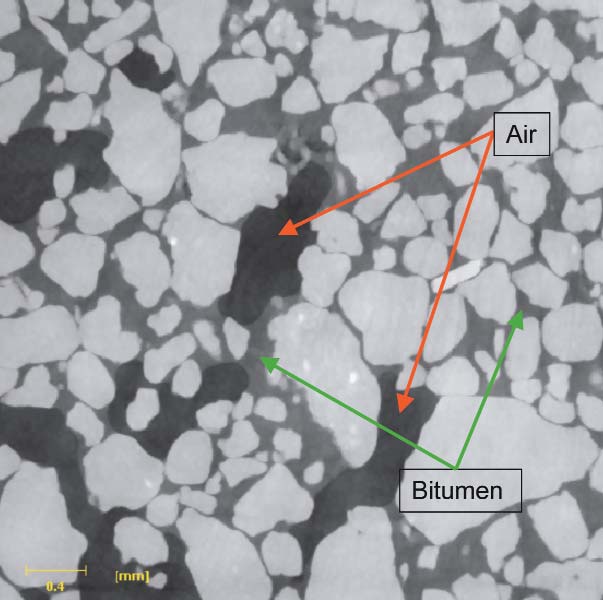 Rocks
are formed in several ways, but usually end up as moderately flat
layers, at least initially (mountain building comes later). As
successive layers are laid on top of each other, the Earth
builds a sequence of rocks with varying physical properties.
Some layers will have open spaces, called pores or porosity,
that contain fluids (water, oil, or gas). A rock on Earth with
porosity cannot be "empty" -- they must contain something, even
if it is only air. Rocks
are formed in several ways, but usually end up as moderately flat
layers, at least initially (mountain building comes later). As
successive layers are laid on top of each other, the Earth
builds a sequence of rocks with varying physical properties.
Some layers will have open spaces, called pores or porosity,
that contain fluids (water, oil, or gas). A rock on Earth with
porosity cannot be "empty" -- they must contain something, even
if it is only air.
 Microphotograph of a rock -- black colour is the porosity
where Microphotograph of a rock -- black colour is the porosity
where
oil, gas, and water can be held inside the rock
Think of a porous rock as similar to a
huge sponge full of holes that can soak up fluids. Although we
often talk about "oil pools", these are not tanks of oil
underground -- they are porous rocks. The porosity, or quantity
of open space relative to the total rock volume, can range from
near zero to as much as 40%. Obviously, higher values of this
physical property of a rock are good news.
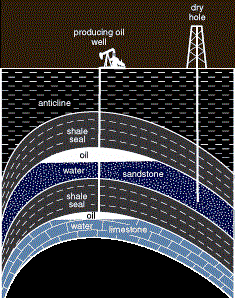 Some
rocks have very little porosity and do not hold much in the way
of fluids. These are often called "tight" rocks. Both tight and
porous rocks can contain animal and plant residue that are
ultimately transformed into hydrocarbons such as coal, oil, or
natural gas that we can extract and use to power vehicles and
heat our homes. As the plant and animal residues mature into oil
or gas, they may migrate through porosity or natural fractures
in the rock until trapped by a non-porous rock structure.
Sometimes a rock only sources itself or an adjacent porous rock,
so little migration occurs. Some
rocks have very little porosity and do not hold much in the way
of fluids. These are often called "tight" rocks. Both tight and
porous rocks can contain animal and plant residue that are
ultimately transformed into hydrocarbons such as coal, oil, or
natural gas that we can extract and use to power vehicles and
heat our homes. As the plant and animal residues mature into oil
or gas, they may migrate through porosity or natural fractures
in the rock until trapped by a non-porous rock structure.
Sometimes a rock only sources itself or an adjacent porous rock,
so little migration occurs.
An anticline, the simplest form of petroleum trap 
Rocks that are capable of holding hydrocarbons in economic
quantities are called reservoir rocks. Rocks in which the plant
and animal residue has not been fully converted to useful
hydrocarbons are called source rocks. Some rocks are both source
and reservoir: others are barren of hydrocarbons, and some
others may act as the trapping mechanism that keeps hydrocarbons
from migrating to the surface and escaping.
A trap is what keeps oil and gas in the rocks until we drill
wells to extract the hydrocarbons. Coal, being a solid, doesn't
need a trap to be kept in place.
  Reservoirs
that contain oil or gas also contain water. The quantity of
water relative to the porosity is called the water saturation.
In the illustrations, the brown colour is solid rock grains and
the space around the grains is the porosity. The black colour is
the hydrocarbon and the white is the water, which forms a thin
film coating the surfaces of each rock grain. This is a
water-wet reservoir (left). In an oil-wet reservoir, the black
and white colours are reversed (right). Reservoirs
that contain oil or gas also contain water. The quantity of
water relative to the porosity is called the water saturation.
In the illustrations, the brown colour is solid rock grains and
the space around the grains is the porosity. The black colour is
the hydrocarbon and the white is the water, which forms a thin
film coating the surfaces of each rock grain. This is a
water-wet reservoir (left). In an oil-wet reservoir, the black
and white colours are reversed (right).
Finding and evaluating the economics of such reservoirs is the
job of teams of geoscientists and engineers in petroleum and
mining companies. A petrophysicist, or someone playing this
role, will be part of that team.
Once a useful accumulation has been found, drilling, completion,
and production engineers take over to put wells on stream. Oil
production may initially flow to surface due to the pressure in
the reservoir. Some oil pools do not have enough pressure to do
this and need to be pumped. Depending on the reservoir drive
mechanism, some wells that start flowing will later need to be
pumped. Water may be produced with the oil. It is separated and
disposed of by re-injection into a nearby unproductive reservoir
layer. You can't just dump the water in the nearest swamp.
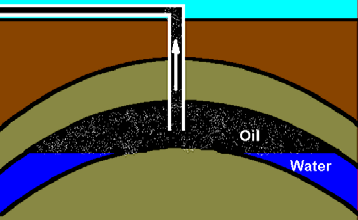
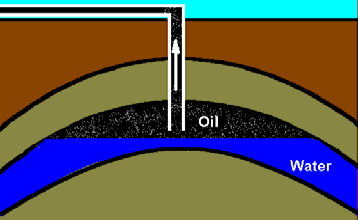
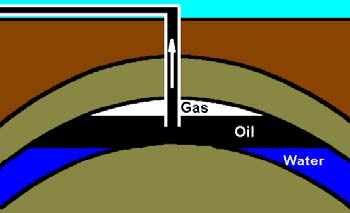
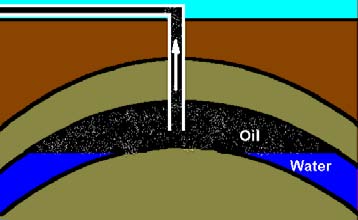
Aquifer Drive -- Before ... and After some production
Gas Cap Drive
Gas Expansion Drive
An aquifer drive mechanism usually maintains the reservoir
pressure for some time but may drop off gradually. Recovery factors vary from 30 to 80% of the oil in place. The oil water
contact rises as production depletes the oil. A gas cap drive
pushes oil out as the gas expands. Recovery factor is similar to
aquifer drive. There may or may not be some aquifer support.
the gas oil contact drops as the oil is depleted. Gas expansion
reservoirs do not have aquifer or gas cap support. Gas dissolved
in the oil expels oil into the well bore because the pressure at
the well bore is below the reservoir pressure. Recovery factor is
awful - usually less than 10%, but this can be improved to maybe
20% by injecting water nearby to increase or maintain the
reservoir pressure. Water floods, carbon dioxide injection, and
re-injection of produced gas or water can be used in nearly any
reservoir to improve recovery efficiency.
Gas wells do not need pumps, but if they also produce water, a
special process called artificial lift is used to get the water
out. That water is also disposed of legally.
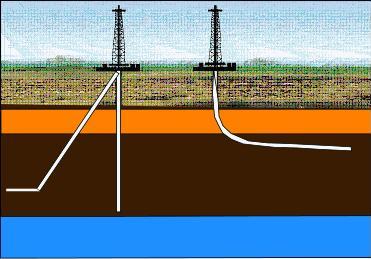 The
economics of a reservoir varies with improving technology.
Bypassed reservoirs, discovered and ignored years ago, are now
economic due to technical improvements in drilling practices and
reservoir stimulation techniques. Horizontal wells and deep
water drilling are now common. The use of heat or steam to assist
production of heavy oil or bitumen, and multi-stage hydraulic fracturing to
stimulate production in tighter reservoirs are relatively new
techniques and relatively economic today. Obviously the specific
price of oil or gas after delivery to the customer plays an
important role in how much effort can be expended to recover oil
and gas from underground. The
economics of a reservoir varies with improving technology.
Bypassed reservoirs, discovered and ignored years ago, are now
economic due to technical improvements in drilling practices and
reservoir stimulation techniques. Horizontal wells and deep
water drilling are now common. The use of heat or steam to assist
production of heavy oil or bitumen, and multi-stage hydraulic fracturing to
stimulate production in tighter reservoirs are relatively new
techniques and relatively economic today. Obviously the specific
price of oil or gas after delivery to the customer plays an
important role in how much effort can be expended to recover oil
and gas from underground.
There is controversy, of course, about new technology. Just as
the Luddites resisted the weaving machines in the early 1800's,
modern Luddites insist that the old ways of oil and gas
extraction are best, while at the same time complaining loudly
about the price of gasoline at the pumps or the cost of
electricity for their air conditioners. You can't have low-cost
and low-tech at the same time.
Green
alternatives are 50 to 100 years away. Every green technology
needs oil to make the required plastics and fuel the
manufacturing and delivery
systems. The electricity grid is far too fragile to fuel
extensive use of electric vehicles anywhere, let alone everywhere. And where
would all that electricity come from (coal?). Clean coal is more
oxymoronic than military intelligence. So if you and the
other 7 Billion people on this planet want to live a comfortable
life, get used to oil and its risks. Staying in bed is risky too
-- more people die in bed than anywhere else.
For the record, I've been off the grid with wind or solar since 1984.
But I live in the middle of nowhere so the esthetics don't
bother the neighbours. What have
you done to green-up this world?
|
|
|
Page Views ---- Since 01 Jan 2015
Copyright 2023 by Accessible Petrophysics Ltd.
CPH Logo, "CPH", "CPH Gold Member", "CPH Platinum Member", "Crain's Rules", "Meta/Log",
"Computer-Ready-Math", "Petro/Fusion Scripts" are Trademarks of the Author
|

